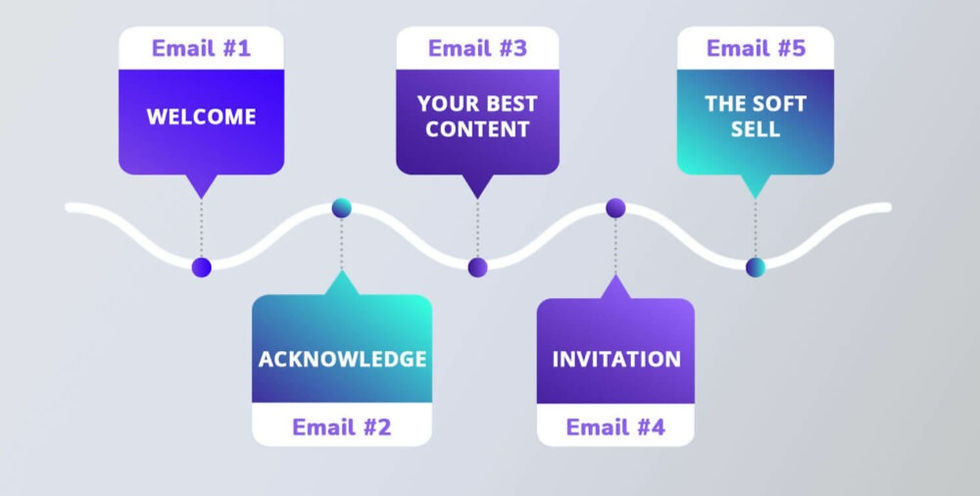5 Different Types of Email Sequences With Examples
- ClickInsights

- May 19, 2023
- 3 min read
Updated: Jun 12, 2023
Email marketing is a powerful tool for businesses to connect with their audience and drive sales. It's hardly surprising that email marketing, given its extensive use and proven advantages, offers a substantial return on investment. Typically, for every dollar you invest in email marketing, you can anticipate an average return of $40.
But simply sending a one-off email to your list isn't always enough to make an impact. That's where email sequences come in. Email sequences are a series of emails that are sent to subscribers over a period of time. These sequences can be automated, and they are designed to nurture leads, promote products or services, and re-engage subscribers who have gone quiet. In this article, we'll explore the different types of email sequences and provide examples of each.

1. Welcome Email Sequences
A welcome email sequence is typically the first set of emails that a new subscriber receives. These emails should provide a warm welcome to your brand and set the tone for your relationship with the subscriber. It can include a thank you message, an introduction to your brand, a discount code or offer, and information on how to get the most out of your emails.
Example: Loft's welcome email sequence includes a thank you message, an introduction to their brand, and a discount code for first-time shoppers.
2. Nurture Email Sequences
A nurture email sequence is designed to educate and engage subscribers over time. These emails can provide value to your audience by sharing educational content, helpful tips, and insights. The goal of a nurture email sequence is to build trust and establish your brand as a thought leader in your industry.
Example: HubSpot's nurture email sequence includes a series of helpful blog posts on marketing, sales, and customer service.
3. Promotional Email Sequences
Promotional email sequences are a powerful way to generate revenue by promoting your products or services to your email subscribers. These sequences typically consist of a series of emails that highlight your latest product launches, exclusive offers, and limited-time discounts.
The key to creating effective promotional email sequences is to make your subscribers feel special by offering them exclusive discounts and sneak peeks. You can also use social proof by highlighting customer reviews and testimonials, which can help to increase trust and credibility with your audience.
Promotional email sequences can be used to drive traffic to your website, generate sales, and increase customer loyalty. By creating urgency with limited-time offers, you can encourage subscribers to take action and make a purchase.
Example: A beauty brand may create a promotional email sequence to launch a new skincare line. The first email could be a teaser, announcing the upcoming launch and inviting subscribers to sign up for early access. The second email could provide more details about the new products, including ingredients and benefits, and offer a limited-time discount for pre-orders. The third email could include customer reviews and testimonials, highlighting the effectiveness of the new skincare line, and encouraging subscribers to make a purchase before the pre-order period ends.
4. Re-Engagement Email Sequences
A re-engagement email sequence is designed to win back subscribers who have gone quiet. These emails can include a message asking if the subscriber still wants to receive emails, a survey to gather feedback, and an exclusive offer to encourage the subscriber to engage with your brand again.
Example: Dropbox's re-engagement email sequence includes a message asking if the subscriber still wants to receive emails and an offer to upgrade their account.
5. Abandoned Cart Email Sequences
An abandoned cart email sequence is meant to bring back customers who have left items in their shopping cart without making a purchase. These emails can include a reminder of the items left in the cart, a discount code to incentivize the purchase, and a message encouraging the customer to complete their purchase.
Example: ASOS's abandoned cart email sequence includes a reminder of the items left in the cart, a discount code, and a message encouraging the customer to complete their purchase.
Conclusion
Email sequences can be a powerful tool for businesses to connect with their audience and drive sales. By understanding the different types of email sequences and implementing them in your email marketing strategy, you can build relationships with your subscribers, establish your brand as a thought leader, and generate revenue. Remember to personalize your email sequences to your audience and always provide value in your emails. Start experimenting with email sequences in your next email marketing campaign and see how they can benefit your business.


google 优化 seo技术+jingcheng-seo.com+秒收录;
Fortune Tiger Fortune Tiger;
Fortune Tiger Fortune Tiger;
Fortune Tiger Fortune Tiger;
Fortune Tiger Slots Fortune…
站群/ 站群
gamesimes gamesimes;
03topgame 03topgame
EPS Machine EPS Cutting…
EPS Machine EPS and…
EPP Machine EPP Shape…
Fortune Tiger Fortune Tiger;
EPS Machine EPS and…
betwin betwin;
777 777;
slots slots;
Fortune Tiger Fortune Tiger;